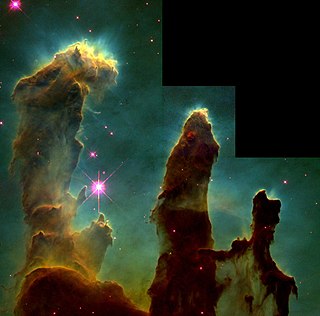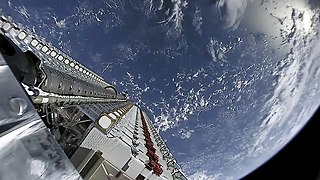Related Research Articles

A space telescope or space observatory is a telescope in outer space used to observe astronomical objects. Suggested by Lyman Spitzer in 1946, the first operational telescopes were the American Orbiting Astronomical Observatory, OAO-2 launched in 1968, and the Soviet Orion 1 ultraviolet telescope aboard space station Salyut 1 in 1971. Space telescopes avoid several problems caused by the atmosphere, including the absorption or scattering of certain wavelengths of light, obstruction by clouds, and distortions due to atmospheric refraction such as twinkling. Space telescopes can also observe dim objects during the daytime, and they avoid light pollution which ground-based observatories encounter. They are divided into two types: Satellites which map the entire sky, and satellites which focus on selected astronomical objects or parts of the sky and beyond. Space telescopes are distinct from Earth imaging satellites, which point toward Earth for satellite imaging, applied for weather analysis, espionage, and other types of information gathering.

A retroreflector is a device or surface that reflects radiation back to its source with minimum scattering. This works at a wide range of angle of incidence, unlike a planar mirror, which does this only if the mirror is exactly perpendicular to the wave front, having a zero angle of incidence. Being directed, the retroflector's reflection is brighter than that of a diffuse reflector. Corner reflectors and cat's eye reflectors are the most used kinds.

Project Echo was the first passive communications satellite experiment. Each of the two American spacecraft, launched in 1960 and 1964, were metalized balloon satellites acting as passive reflectors of microwave signals. Communication signals were transmitted from one location on Earth and bounced off the surface of the satellite to another Earth location.

Space advertising is the practice of advertising in space. This has usually been done with product placements during crewed space missions.

The Norton Museum of Art is an art museum located in West Palm Beach, Florida. Its collection includes over 8,200 works, with a concentration in European, American, and Chinese art as well as in contemporary art and photography. In 2003, it overtook the John and Mable Ringling Museum of Art, in Sarasota, to became the largest museum in Florida.

Space art or astronomical art is a genre of art that focuses on the universe as a frame of reference. Like other genres, space art has many facets and encompasses realism, impressionism, sculpture, abstract imagery, and zoological art. Though artists have long produced art with astronomical elements, the genre of space art itself began only when technological advancement allowed for more detailed observation of the night sky. Space art also attempts to communicate ideas related to space, often including an artistic interpretation of cosmological phenomena and scientific discoveries. In some cases, artists who consider themselves space artists use more than illustration and painting to communicate astronomy or works depicting space, with some working directly with spaceflight technology and scientists in attempts to expand the arts, humanities, and cultural expression relative to space exploration.

Trevor Paglen is an American artist, geographer, and author whose work tackles mass surveillance and data collection.

The Georges Lemaître ATV, or Automated Transfer Vehicle 5 (ATV-5), was a European uncrewed cargo spacecraft, named after the Belgian astronomer Georges Lemaître. The spacecraft was launched during the night of 29 July 2014, on a mission to supply the International Space Station (ISS) with propellant, water, air, and dry cargo. It was the fifth and final ATV to be built and launched. Georges Lemaître was constructed in Turin, Italy, and Bremen, Germany. Cargo loading was completed in Guiana Space Center on 23 July 2014.

Tavares Henderson Strachan is a Bahamian-born conceptual artist. His contemporary multi-media installations investigate science, technology, mythology, history, and exploration. He lives and works in New York City and Nassau, Bahamas.
EchoStar XVI is an American geostationary communications satellite which is operated by EchoStar. It is positioned in geostationary orbit, and will be located at a longitude of 61.5° West, from where it is intended to provide direct broadcasting of high-definition television services to the United States for Dish Network.
Roy Nachum is an Israeli New York-based contemporary artist working in painting, sculpture, and installation.

BLITS (Ball Lens In The Space) is a Russian satellite launched on September 17, 2009, as a secondary payload on a Soyuz-2.1b/Fregat, from the Baikonur Cosmodrome in Kazakhstan. The satellite is totally passive and spherical, and is tracked using satellite laser ranging (SLR) by the International Laser Ranging Service. The design of BLITS is based on the optical Luneburg lens concept. The retroreflector is a multilayer glass sphere; it provides uniform reflection characteristics when viewed within a very wide range of angles, and can provide a cross-section sufficient for observations at low to medium orbit heights. A similar design was already tested on a smaller laser reflector carried on board of the METEOR-3M spacecraft launched on December 10, 2001.

Starlink is a satellite internet constellation operated by Starlink Services, LLC, a wholly-owned subsidiary of American aerospace company SpaceX, providing coverage to over 70 countries. It also aims to provide global mobile broadband.
Pacific Standard Time: LA/LA is an art event celebrating Latin American art in over 70 museums and galleries in Los Angeles and Southern California held from September 2017 through early 2018.

Humanity Star was a reflective passive satellite designed to produce visible, pulsing flares. The satellite was launched into orbit by an Electron rocket on 21 January 2018 and entered into the atmosphere on 22 March 2018. The reaction to Humanity Star was mostly negative by astronomers, as it interfered with their observations.
For Freedoms is an artist-run platform for civic engagement, discourse, and direct action for artists in the United States. Co-founded by Hank Willis Thomas, Eric Gottesman, Michelle Woo, and Wyatt Gallery in 2016, For Freedoms has partnered with US-based institutions and artists for activations including town halls, exhibitions and installations, public programs, billboard campaigns, and artist residencies. In June 2018, For Freedoms launched the 50 State Initiative, described as the "largest-ever public art project in the US".
Five Brushstrokes is a 1983–84 sculpture series from the Brushstrokes series by Roy Lichtenstein that was fabricated in 2012 and acquired by the Indianapolis Museum of Art in 2013. It was installed in front of the entrance of the main building of the museum. The painted and fabricated aluminum and steel sculptural series is a gift of the Robert L. and Marjorie J. Mann Fund and partial gift of the Roy Lichtenstein Foundation. The first showing of Element E of the series was displayed in the rotunda of the Tweed Courthouse in 2003 as part of a Lower Manhattan public art exhibit.
Unseen Skies is a 2021 documentary film directed by Yaara Bou Melhem. The film documents the work of artist Trevor Paglen as he undertakes one of his most ambitious projects, Orbital Reflector, launching an artwork into space to highlight the global impact of technology in the 21st century. The film had its premiere at the San Francisco International Film Festival in April 2021.
References
- ↑ King, Bob (December 5, 2018). "SpaceX Launches Orbiting Sculpture in the Sky". Sky and Telescope. Retrieved January 15, 2019.
- ↑ "Artist Trevor Paglen's $1.5 Million 'Orbital Reflector' Is Officially Lost in Space Thanks to President Trump's Government Shutdown". artnet News. May 2, 2019. Retrieved October 3, 2020.
- ↑ "How Donald Trump ruined a space art project". The Guardian. May 7, 2019.